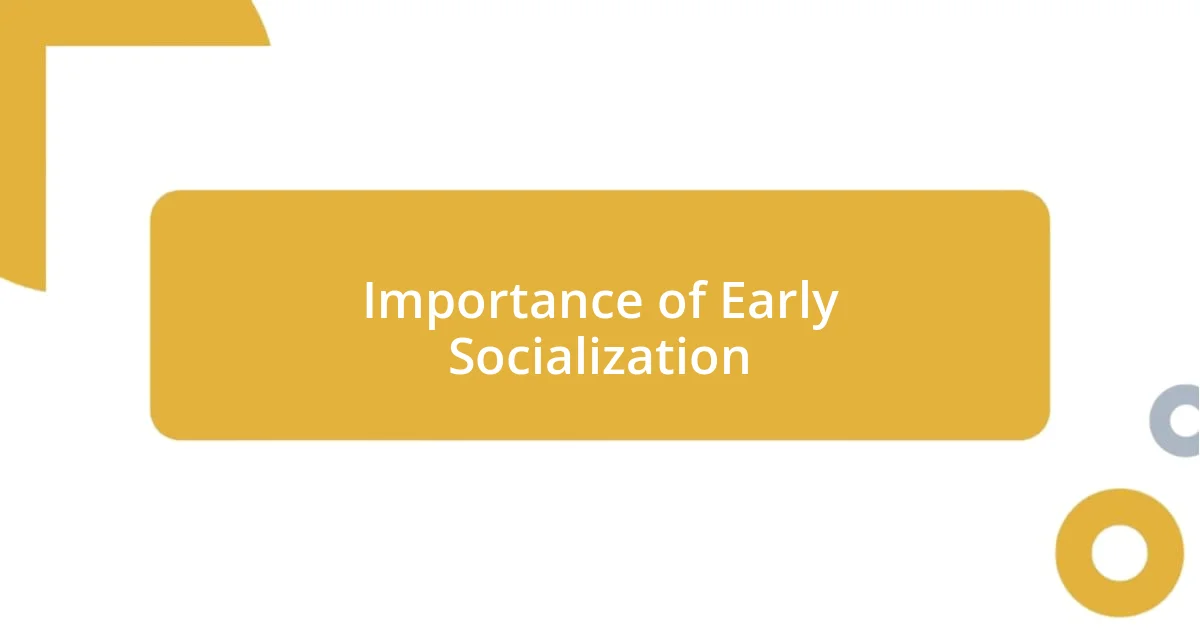Key takeaways:
- Pet socialization is essential for developing a pet’s confidence, adaptability, and reducing behavioral issues through diverse experiences and positive reinforcement.
- Early socialization lays the foundation for a pet’s lifelong behavior and strengthens bonds with humans, preventing fear and aggression.
- Monitoring pets’ social interactions and handling challenges with patience promotes healthy friendships and encourages personal growth for both pets and owners.

Understanding Pet Socialization
Pet socialization is a vital process that lays the foundation for a companion animal’s behavior and well-being. When I first adopted Bella, my shy rescue dog, I quickly realized how crucial it was for her to encounter various people and other pets. Have you ever noticed how a well-socialized pet seems more confident and relaxed? I’ve found that socialization not only helps with behavioral issues but also enriches the pet’s life tremendously.
The more varied experiences a pet has—like meeting different dogs at the park or being around children—the more adaptable they become. I still remember that time I took Bella to a bustling street fair. At first, she was overwhelmed, but slowly she began to appreciate the new sights and sounds. It made me wonder if every pet can thrive in such environments with the right encouragement and patience.
Effective socialization is not just about exposure; it’s also about positive reinforcement. I’ve learned that pairing new experiences with treats or praise can create lasting, positive memories for my pets. How do you nurture your pet’s journey into the world? Remember, each interaction can shape their future behavior and outlook, and it’s exciting to be part of that transformation.

Importance of Early Socialization
Early socialization is crucial for pets because it sets the stage for their behavior throughout life. I remember when I introduced my cat, Whiskers, to my neighbor’s dog. Initially, he was hesitant, but after a few gentle meetings, he became more at ease around larger animals. This experience reinforced my belief that starting socialization young can significantly reduce fear and anxiety in pets.
Not only do well-socialized pets show better behavior, but they also develop stronger bonds with their human companions. My friend has a puppy that was regularly exposed to different environments and people. Now, that pup eagerly greets guests at the door, showcasing a level of comfort that’s truly heartwarming. This highlights the value of early exposure—it’s about building a confident, well-adjusted companion who can thrive in various settings.
Furthermore, early socialization helps prevent behavioral problems that may arise from fear or aggression. I once met a rescue dog that had never been around children, which made him exceptionally nervous in a family environment. With more early engagement and interaction with kids, I believe he could have adjusted more smoothly. Every positive encounter contributes to shaping a pet’s temperament, ultimately leading to a happier life for both the pet and the owner.
| Benefits of Early Socialization | Effects of Lack of Socialization |
|---|---|
| Confidence in new environments | Fear and anxiety in unfamiliar situations |
| Better relationships with people and pets | Aggression or avoidance behaviors |
| Adaptability to changes | Difficulties adjusting to new experiences |

Effective Training Techniques
Positive reinforcement has been a game-changer in my training efforts. I often found that using treats or praise when my pets displayed the desired behavior made them more eager to learn. Just last week, I took Bella to a new dog park where she met some energetic pups. Each time she approached another dog calmly, I offered her a treat and lots of verbal encouragement. It was incredible to see her confidence grow in such a short time.
Here are a few effective training techniques I’ve embraced:
- Clicker Training: This method involves using a clicker to mark the exact moment your pet does something right, followed by a reward. It creates a clear communication channel.
- Desensitization: Gradually introducing pets to stimuli that usually cause fear helps them adapt. For instance, I played recordings of thunder when Bella was relaxed, rewarding her each time she maintained her calm.
- Group Classes: I’ve discovered that attending training classes not only enhances skills but also promotes socialization with other pets. Bella made friends there, and seeing her play made my heart swell.
- Short Sessions: Keeping training sessions brief yet frequent has proven effective, especially with pets that lose focus easily. When I first started training Bella, just 5-10 minute sessions worked wonders!
The emotional bonds I’ve formed with my pets through these techniques have been incredibly rewarding. Each new experience strengthens our connection, and I can truly see the joy on Bella’s face when she masters a new skill. Training isn’t just about commands; it’s a journey of mutual understanding and growth.

Setting Up Playdates
Setting up playdates for my pets has been one of the most enjoyable aspects of their socialization journey. I still vividly remember the first time I invited a friend over with her gentle Labrador, Max. Bella was nervous at first, but seeing Max’s friendly demeanor helped her relax. It made me realize how crucial it is to pick the right playdate partner—animals that complement each other’s energy levels can make the experience so much smoother.
When planning a playdate, I always prioritize a neutral location. This can be a backyard or a nearby park where both pets have the space to roam without feeling territorial. I recall the excitement on Bella’s face when we ventured to a local dog park for her first group playdate. Watching her mingle with other dogs while I stood on the sidelines was such a rewarding feeling. It reminded me that having a controlled environment can ease any anxieties and allow pets to interact freely and safely.
I can’t stress enough how important it is to supervise during these playdates. One of my friends once thought her dogs could handle themselves without any oversight, and it ended in a minor spat. After that, she learned the hard way about the need for attentive supervision. Keeping an eye on their behavior allows me to step in if play gets too rough while also giving me a chance to encourage positive interactions. Isn’t it comforting to know that, with a little guidance and attention, we can help our furry friends establish lifelong friendships?

Introducing New Environments
When I’m introducing my pets to new environments, I always try to stay calm myself. The first time I brought Bella into a bustling pet-friendly café, I remember holding my breath. She seemed overwhelmed by the strange smells and sounds, but I opted to take it slow. We sat down at a quiet corner, allowing her to observe before diving into the action. It was fascinating to watch as her curiosity gradually pushed out her anxiety.
Exploring new places can be an adventure for both me and my pets. I recall taking Bella to a local farmer’s market. The vibrant atmosphere filled with stalls, people, and other animals was delightful yet daunting for her at first. I can still picture how she kept looking up at me, scanning my face for reassurance. Whenever she took a step forward, I rewarded her with treats, coaxing her to engage with the busy surroundings rather than retreating into her shell. Can you imagine the exhilaration I felt watching her transform from a shy pup into a confident explorer?
Timing is crucial when it comes to exposure, so I always pay attention to Bella’s cues. If she starts to look anxious, I gently redirect her focus or take a break. One visit to a beach, for instance, had us retreating under the shade of an umbrella after she became overwhelmed by the surf crashing and children playing. I shared my snack with her during this downtime, strengthening our bond and reminding her that new environments can be fun—as long as we take our time. It’s about creating positive associations, don’t you think?

Monitoring Social Behaviors
As I observe my pets during social interactions, I’ve learned just how insightful their body language can be. The first time Bella met a feisty Jack Russell, I noticed how her ears pulled back while her tail wagged nervously. It was a clear sign that she was uncertain but wanted to engage. Reading these cues helps me gauge whether I should encourage her to play or step in and provide comfort instead.
I often find myself taking mental notes about how different pets react in various situations. For instance, when Bella was around a shy Golden Retriever, she instinctively approached with gentle movements. This empathetic behavior reinforced my belief that pets have their own social skills, and it cements the importance of monitoring interactions closely. It’s rewarding to realize that by watching their interaction styles, I can help nurture their friendships. What do you think—can animals understand each other better than we realize?
After playdates, I always reflect on the dynamics I observed. One day, while watching Bella interact with a high-energy Beagle, I noticed that her playful demeanor began to wane as the Beagle’s enthusiasm escalated. This allowed me to step in before it became overwhelming for her. I’ve come to appreciate this part of the learning process—both for my pets and myself. We all grow through these connections, don’t you agree?

Handling Socialization Challenges
Handling socialization challenges with my pets often involves a fair amount of patience. I remember a time when Bella met a group of enthusiastic dogs at a local park. Initially, she froze in place, her body tense and uncertain. It was hard for me to watch, but I realized that my calm presence would help guide her. I squatted down and called her gently, creating a safe space where she could choose when to engage. It was a small reminder that sometimes, just being there is enough.
Then there are moments when Bella surprises me with her resilience. During a particularly chaotic dog event, she seemed overwhelmed by all the barking and excitement. I felt my heart race as I watched her retreat behind my legs, but I took a deep breath, knowing that this situation could turn around. Instead of pulling her back, I encouraged her to engage, using a favorite toy to spark her interest. Seeing her curiosity ignite again, as she cautiously approached the other dogs, filled me with relief. Isn’t it incredible how dogs can surprise us when we least expect it?
Every setback provides an opportunity for growth. There was a day when Bella met a larger dog, which startled her and caused her to bark defensively. It stung to see her react that way, but I chose not to scold her. Instead, I calmly removed her from the situation and let her decompress. Later, we practiced greeting techniques at home, reinforcing positive behaviors. The more I approach these challenges with understanding, the closer we get to fostering that ideal confidence in her. What if this journey is less about perfection and more about progress together?













